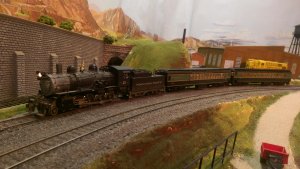Hi all,
I recently bought some Walthers Proto 85' PS and Budd cars. I am in the process of changing the couplers to Kadee. Since i had only #158 available (the ones i use on freight cars and locomotives), i tried some 158s on a few cars. Dragging a consist by hand as a quick (but inconclusive and not adequate) test did not exhibit any issues around a 30" radius curve*.
Having read about issues with uncoupling on longer cars when using the "scale" 58/158 couplers, is the 148 option a safer bet? On the flip-side, are the 148 ones troublesome to uncouple with passenger cars and diaphragms in comparison to 158 ones? As you can understand, i am trying to decide if i should get more 158s or go for 148 ones for the passenger cars.
*I have a minimum 30" radius on this layout, and 36" on the next/future layout, with #6 and #8 turnouts (Peco code 83) on the passenger line / coach yards. I think i should not need to mix/match #146 with #148 which i have read around as a solution for tighter radii.
Many thanks in advance for your time and replies.
Yannis
PS. Kadee recommends #146 on Budd built cars, and #148 (or others...) in other Passenger cars, but there is no specific reference of Pullman or ACF cars so i guess the 148 is a go.
I recently bought some Walthers Proto 85' PS and Budd cars. I am in the process of changing the couplers to Kadee. Since i had only #158 available (the ones i use on freight cars and locomotives), i tried some 158s on a few cars. Dragging a consist by hand as a quick (but inconclusive and not adequate) test did not exhibit any issues around a 30" radius curve*.
Having read about issues with uncoupling on longer cars when using the "scale" 58/158 couplers, is the 148 option a safer bet? On the flip-side, are the 148 ones troublesome to uncouple with passenger cars and diaphragms in comparison to 158 ones? As you can understand, i am trying to decide if i should get more 158s or go for 148 ones for the passenger cars.
*I have a minimum 30" radius on this layout, and 36" on the next/future layout, with #6 and #8 turnouts (Peco code 83) on the passenger line / coach yards. I think i should not need to mix/match #146 with #148 which i have read around as a solution for tighter radii.
Many thanks in advance for your time and replies.
Yannis
PS. Kadee recommends #146 on Budd built cars, and #148 (or others...) in other Passenger cars, but there is no specific reference of Pullman or ACF cars so i guess the 148 is a go.
Last edited by a moderator:


